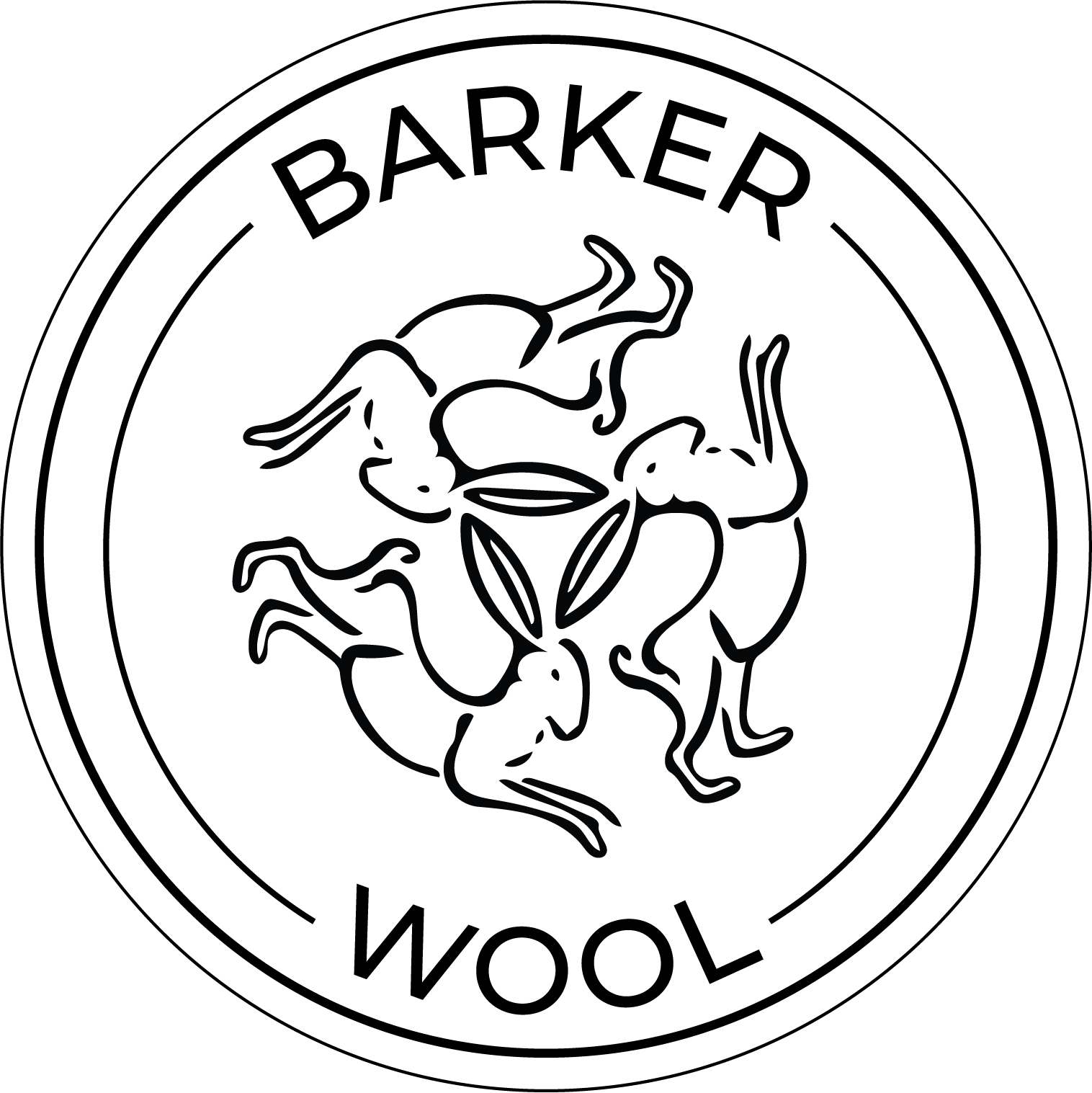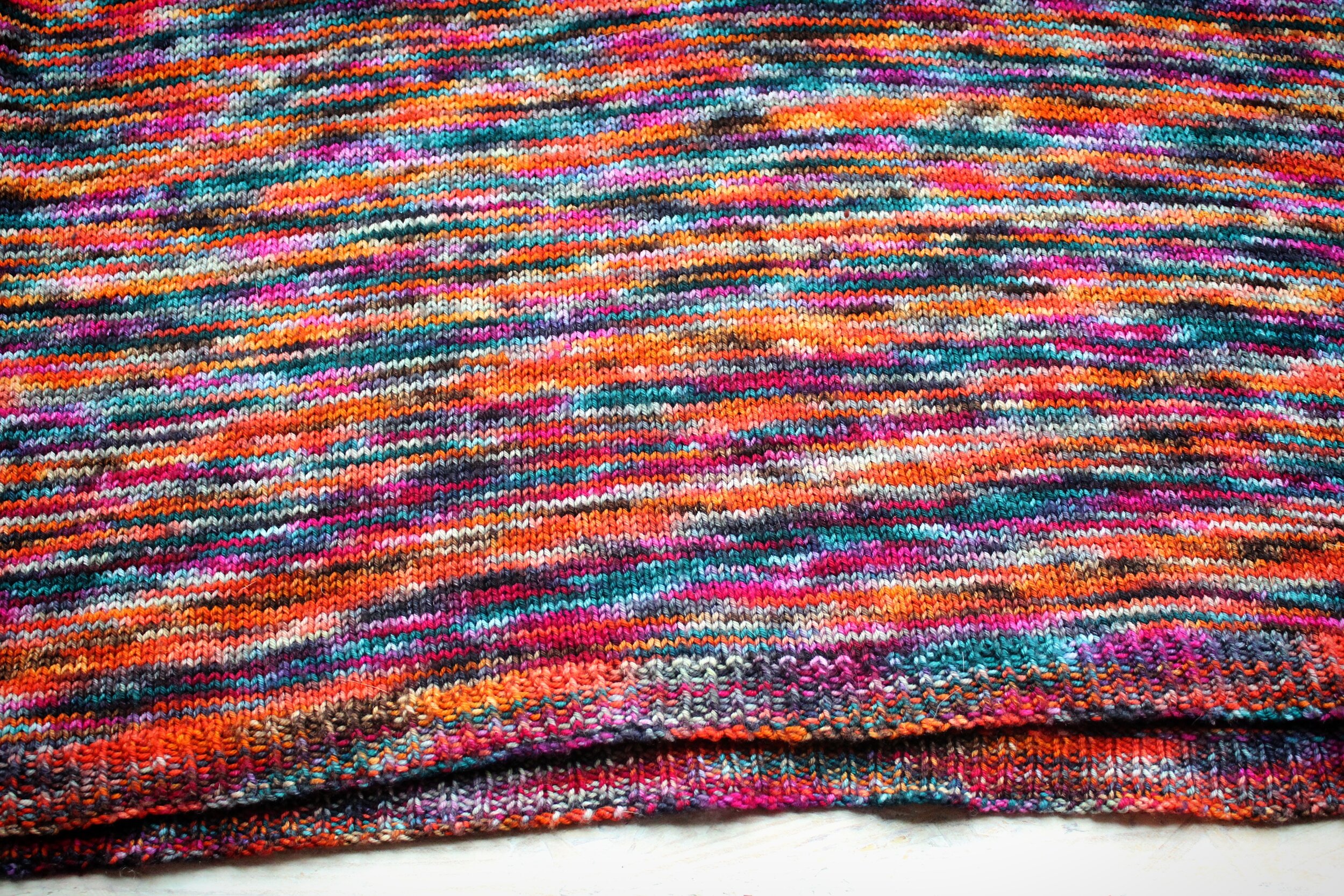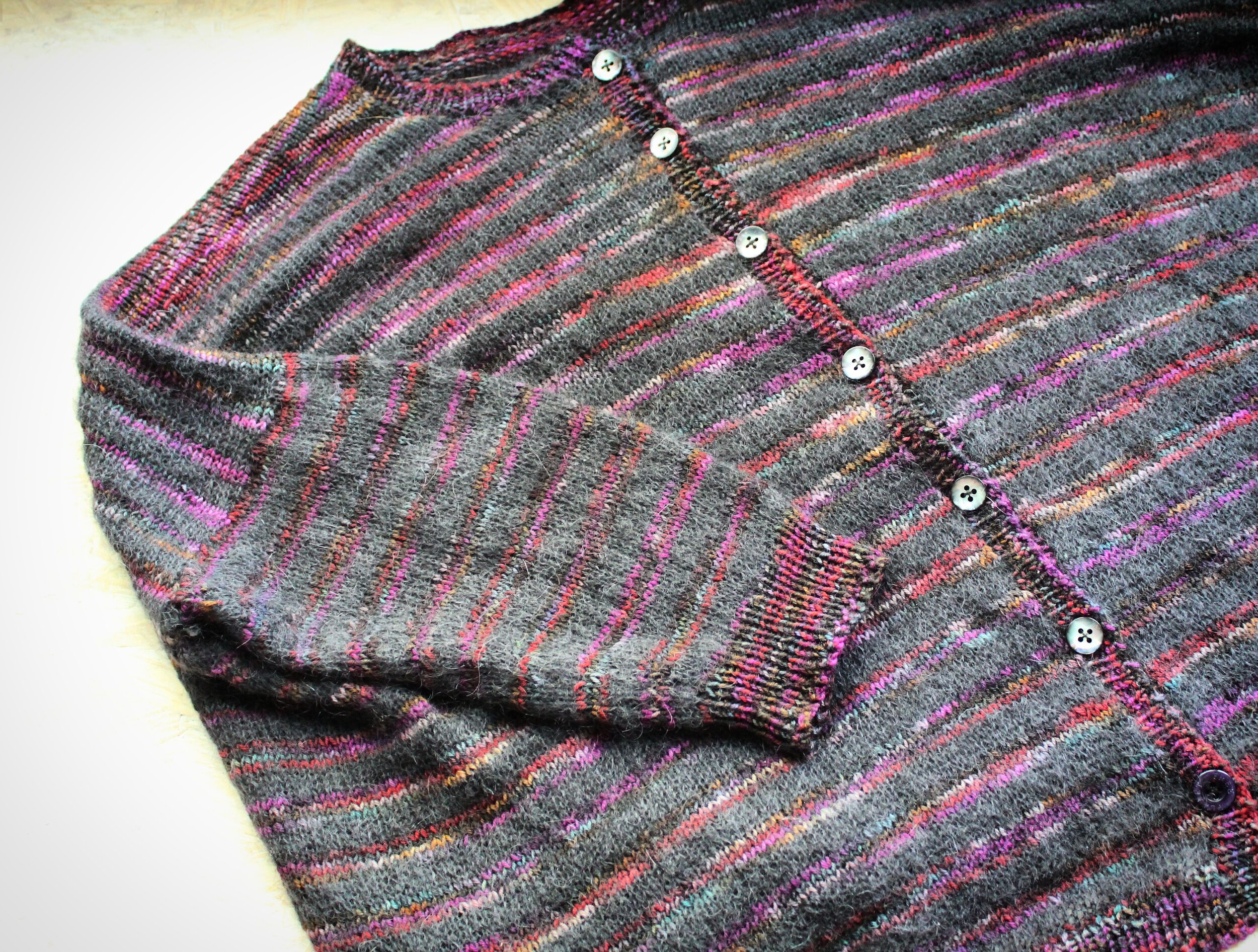Using Variegated Yarns Without Tears
It happens to everyone. You walk into your local yarn shop, the heavens open, and a ray of golden light shines down on that perfect skein that sings to you from across the room. You immediately fall in love with the glorious color combination and can’t imagine anything more perfect. You picture yourself sitting in your favorite spot sipping tea while knitting that special sweater you’ve had in your queue for months. You run as fast as you can to the cash register and buy as many skeins as they have in stock.
Next, you drive straight home, wind your new treasures into tidy cakes, download that perfect pattern, assemble your favorite tools, and knit a gauge swatch. You can still hear the angels singing over your exquisite skeins while casting on stitches for the neckband. Before you know it the raglan increases have flown right off your needles, and you’re ready to divide your stitches for the sleeves. The colors are blending and shifting effortlessly into a symphony of chromatic perfection. You are so pleased with yourself and all is right in your little corner of the world. Onto the body now as you knit row after row in absolute stockinette bliss. Then about two or three inches into the body, it happens. The record scratches. Your magnificent variegated skeins betray you and start pooling in giant color blotches around the belly of your dear sweater. You stare in disbelief and defeat at your glorious disaster.
Now what?
Pretend it’s not happening and just go with the results.
Finish it but probably never wear the sweater out of the house.
Throw it into your WIP pile and hope that it will look different the next time you pick it up.
Give up in despair, frog the whole thing, and bury the sad rewound cakes deep in your stash hoping that one day you’ll find just the right project for the suckers.
Dry your eyes and bravely fight back against the pooling.
If you chose E, then read on.
Pooling is the occurrence of colors stacking up on top of each other as you knit back and forth or in the round making less than attractive blotches of color that distract from the overall look of the work. Understanding the cause of pooling can make it easier to manipulate. It happens because the colors repeat on the skein in a regular, predictable sequence. They start to form a pattern when you knit the same number of stitches each round or row. This is why pooling is often not so noticeable until the regular pattern increases stop as in the body of the sweater in the story above.
Imagine going for a bike ride on a trail in the wilderness. You will see lots of the same things as you ride, but you will not see the same things repeat regularly as you ride down the trail (unless you are riding in a cartoon). Now take a ride around the block in a neighborhood. You will see exactly the same trees and driveways and houses at regular intervals as you make laps around the block. Knitting in the round or flat works similarly if the stitch count doesn’t vary from round to round or row to row. Pooling can’t always be eliminated completely, but it can be manipulated and disguised. I’ve listed below several techniques that are helpful in controlling pooling.
Notice the regular repeats of yellow and red alternating with shapes of blue and purple in the cardigan below. I alternated two skeins of the same colorway which is why each pool looks a bit striped, but I still wound up with noticeable pooling. It is subtle enough that I accepted it, but you can imagine what it would have looked like with a higher contrast colorway and no alternating.
Alternate
If knitting flat, alternate two of the same colorway skeins every row or two and carry the unused strand up the side of the work. The sweater below was knit with two strands of the same high contrast variegated yarn.
Helix Knit
Alternate Skeins using a helical method if you are working in the round. Alternating skeins is always a good idea, even when working with hand-dyed tonals, and helical knitting is a simple way to do it seamlessly. To do it, use two or more strands of the same colorway and divide your number of stitches by how many strands you are using. For example, in a pattern with 100 stitches and two strands of yarn, 100 / 2 = 50. Knit 50 stitches in the first strand, drop that strand, slip three stitches purlwise, and start knitting with the second strand. Continue knitting until you come to three stitches before the first strand. Drop the current one, slip three stitches purlwise, and pick up the first strand. Continue in this manner. The junction between skeins will always have a buffer of three stitches, and the junction will shift three stitches to the right with each round. This technique can be used with multiple strands, and the more strands used, the less visible pooling will be.
The Travelers Loop pictured here uses Ocean, a teal blue tonal, paired with Lyra, a subtly variegated blend of muted and bright pinks knit helically in garter stitch.
Pair with a tonal.
Incorporate stripes into your pattern by alternating your variegated colorway with a complimenting tonal, or try knitting small stripes of three or four rows of each color. My Elton Cardigan (by Joji Locatelli) uses four-row stripes to break up the pooling in Belladonna.
Marl
Marl by holding two strands of the same colorway together if the gauge allows, or choose a complimenting tonal to hold with the variegated skein. Gossamer is my favorite base to add because it provides an overlying fog of color that calms down the contrast between the colors in the variegated skein. The Kith & Kin Cowl pictured here uses both marling with Gossamer and linen stitch to disguise pooling.
Vary stitch counts.
If the pooling is too drastic in a sweater, then try knitting a shawl that features regular increases or decreases throughout the pattern. This will help break up the predictable color repeats that cause pooling.
Add Texture
Textured stitch patterns make your yarn do gymnastics. The texture found in simple seed stitch or linen stitch is often enough to visually break up the look of pooling. Many other textured stitches are great at hiding it as well. My current favorite is the Anemone Stitch found here in my Wildflowers shawl. The stitch pattern breaks up the pooling and reminds me of an aerial view of a field of flowers.
The colorway used in this pattern, Austin, is the same as the one pictured above in the example of pooling on page 2. If you look closely you can see that pooling still occurs with this highly-textured pattern, but it is much less noticeable with the addition of texture.
Slip Stitches
Slipped stitch patterns and mosaic patterns are great at making the yarn duck and dodge and therefore break up the regular repeats that cause pooling. The Better Together Wrap pictured here shows definite areas of pooling, but they are disguised by the addition of a tonal colorway and a slipped stitch pattern.
Apply Color Theory
Using some simple color theory rules when choosing variegated yarn may help you choose wisely before making your purchase.
Consider contrast.
Contrast can be demonstrated in color and value.
Complementary colors are colors that are directly opposite each other on the color wheel. They bring the most out of the other and provide the highest contrast. There are three basic sets of complements:
Red & Green,
Purple & Yellow, and
Orange & Blue.
If a skein contains any derivative of these combinations, then the contrast between them in your knitting will be higher. High contrast means higher visibility of pooling. Look for combinations that have analogous, or neighbor colors in the mix. Analogous colors are next-door neighbors on the color wheel and are therefore lower in contrast. Yarn shops often have color wheels on hand and may also be able to help advise you in your selections. There are color wheel apps available for download on your phone as well so you never need to leave home without one!
Contrasting values can be thought of as lights and darks. The same skills that help you separate laundry can help here. Black and white are the most drastic example of high contrast, but pastel shades and saturated ones together in the same skein can give high contrast too.
If avoiding pooling is the goal, then look for skeins that share colors of similar value. (Light + Light or Dark + Dark.)
Use Technology
Try the black & white photo trick if you’re not sure about the contrast in color or value.
Take a picture of the skein with your phone, and turn it into a black & white image by turning the saturation down to zero. If the contrast looks high between the sections of color, then pooling may be more noticeable. If it all looks similar then it may be considered lower contrast and pooling will be less noticeable.
These are just a few ways that I have found to cut down on the visibility of pooling when using variegated yarns. I hope you find these tips useful, and that you will give variegated yarns a chance with new-found confidence. Let me know what you’ve tried in the comments below.












